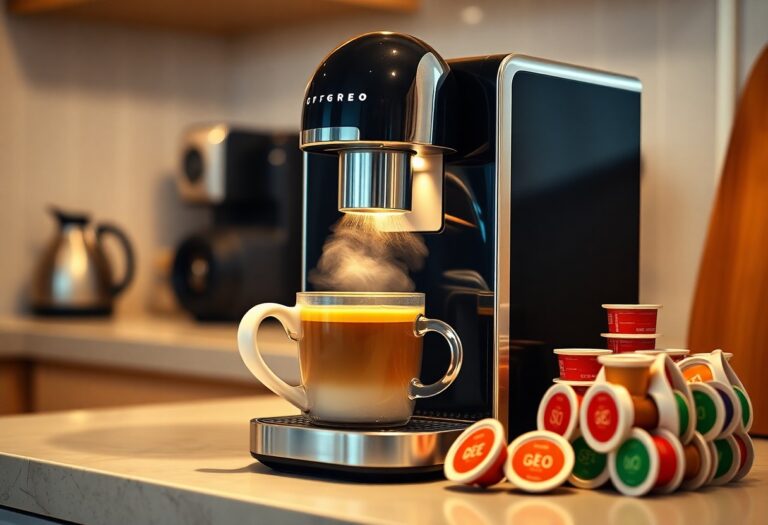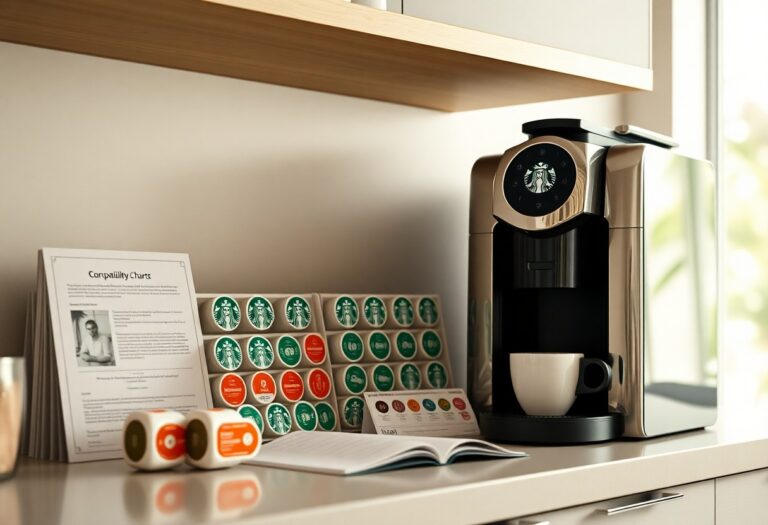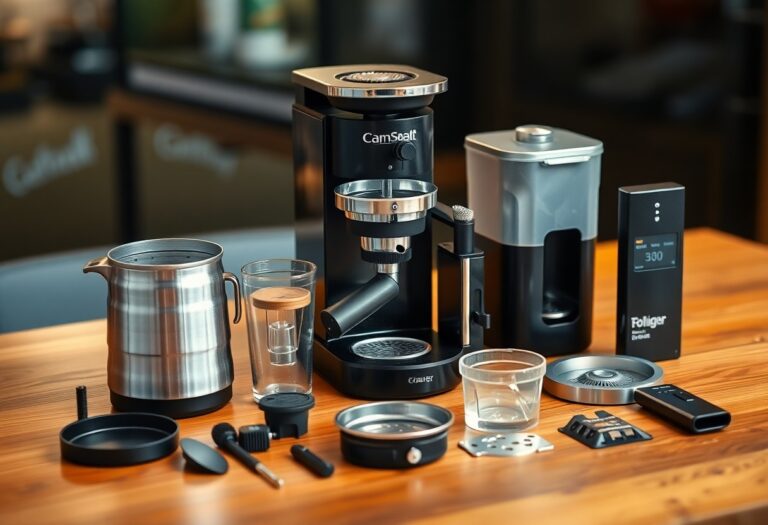What Ground Coffee for an Espresso Machine – Grind Specifications
Just knowing the right grind specifications for your espresso machine can elevate your coffee experience significantly. To achieve that perfect shot, you need to use finely ground coffee, which allows for optimal extraction of flavors. Your grind should resemble that of table salt – too coarse, and your espresso will be weak; too fine, and you risk a bitter taste. Understanding these parameters not only enhances your brew but also ensures the longevity of your machine. With the right grind, you can unlock the full potential of your espresso and enjoy a delightful cup every time.
Key Takeaways:
- The ideal grind size for espresso is fine, resembling table salt, to ensure proper extraction and flavor development.
- Different beans may require slight adjustments in grind size due to their density and roast level; try experimenting to find the perfect balance.
- Freshly ground coffee beans offer superior flavor, making a burr grinder recommended for achieving consistent grind size.
- Pay attention to the brew time; a general guideline is 25-30 seconds for a shot of espresso, which can help indicate if the grind size is appropriate.
- Stale coffee can lead to undesirable flavors, so always opt for grinding your beans just before brewing.

The Science of Grind Size: Unlocking Espresso Potential
The grind size of your coffee beans significantly impacts the extraction process and flavor complexity of your espresso. Understanding this science helps you control the nuances of your brew, allowing you to refine your coffee experience. For optimal results, you want a grind that balances extraction rate and brewing time, ultimately unlocking the full potential of your selected coffee beans.
The Role of Particle Size in Extraction
Particle size influences how water interacts with coffee grounds during extraction. Finer particles increase the surface area, promoting faster extraction, while coarser grounds slow down the process. Finding a balance is key: too fine might lead to over-extraction, creating bitterness, while too coarse can result in under-extraction, leading to sour flavors. The ideal grind for espresso lies within a very fine range, often compared to table salt.
How Grind Consistency Influences Flavor Profile
Grind consistency is as important as the grind size itself. Uniform particle size ensures that each particle extracts evenly, allowing for a well-rounded flavor profile. If your grind varies widely, the resulting brew may feature undesirable bitterness and astringency due to over-extracted particles, while under-extracted particles yield a lackluster taste. This inconsistency results in a disjointed coffee experience, where the rich, nuanced flavors of your beans remain untapped.
For optimal flavor extraction, aim for a consistent grind, ideally between 200-800 microns for espresso. Investing in a quality burr grinder will allow you to achieve this precision. The smooth blending of flavors in your cup comes from every particle participating in the extraction process harmoniously. By prioritizing grind consistency, you’ll enhance sweetness and body while minimizing any harsh or off-putting notes—ultimately leading to a more satisfying espresso shot. This attention to detail can elevate your home brewing to barista-level excellence.
From Coarse to Fine: The Perfect Espresso Grind Spectrum
Finding the sweet spot in the grind size spectrum is vital for a perfect espresso. Typically, espresso requires a fine grind, akin to table salt, allowing for optimal extraction and rich flavors. However, some might find themselves transitioning from I bought an espresso machine, help me choose a ground… discussions highly beneficial, guiding new users in identifying their preferred grind level tailored to their beans and brewing method.
Identifying the Ideal Grind for Espresso Machines
The ideal grind for your espresso machine relies on numerous factors including brew time, pressure, and the specific beans you use. A fine grind minimizes water flow resistance, ensuring proper extraction during the brief brewing period, typically 25-30 seconds. Pay attention to your machine’s specifications, as some models function better with slightly coarser grinds while maintaining optimal taste.
The Impact of Different Beans on Grind Requirements
The type of coffee beans significantly influences your grind requirements, with various origins imparting distinct flavors and brewing characteristics. For example, oils found in dark roasts can create a sludgy texture if ground too fine, while light roasts may require an entirely different approach to unlock their full potential. Each bean variety can shift your grind needs, thus experimenting might reveal your perfect match.
Regarding adapting the grind size based on the beans you’re using, you should consider both the roast level and the flavor profile. For instance, dark roasts, which are more oily, require a slightly coarser grind to prevent clogging and over-extraction. On the other hand, light roasts often need a finer grind to maximize extraction and showcase their nuanced flavors. Understanding these nuances is vital for achieving the best espresso experience tailored to your personal taste preferences.
Beyond the Basics: Techniques for Achieving Ideal Grind
Exploring advanced techniques in grinder settings can elevate your espresso game. You’ll find that fine-tuning your grind not only enhances extraction but also allows for experimentation with flavor profiles. Adjustments can optimize the brew time, yielding results that can transform your daily cup into a café-quality experience. Consider the environment, such as humidity and temperature, as they can affect your grind consistency and require ongoing adjustments for that perfect shot.
Burr Vs. Blade Grinders: Which Reigns Supreme?
Burr grinders consistently outperform blade grinders for espresso, delivering uniform particle sizes necessary for balanced extraction. A burr grinder crushes beans between two surfaces, ensuring that your grind is evenly distributed, which translates to improved flavor clarity. In contrast, blade grinders chop beans unevenly, resulting in a mix of sizes that can lead to both under-extraction and over-extraction in your shots.
Setting Up Your Grinder for Optimal Results
Getting your grinder dialed in is half the battle toward brewing the perfect espresso. Start by using a scale to measure your coffee beans accurately; the general rule is around 18-20 grams for a double shot. Next, experiment with grinder settings to achieve the right consistency—aim for a fine, granulated texture resembling table salt, adjusting as necessary for your specific espresso machine.
For best results, ensure your grinder is calibrated properly based on the coffee beans you’re using and the water temperature. Frequent calibration can help you stay within an ideal range, adjusting the grind size based on the brewing time and extraction: shorter times might need a finer grind, while longer extractions may require coarser settings. Consistency in dosing and tamping also plays a key role; small changes can make a significant difference in flavor and quality. Ultimately, it’s a blend of art and science—take notes on your adjustments to hone in on the perfect brew tailored to your palate.

Troubleshooting Your Espresso Grind: Common Pitfalls
A successful espresso depends heavily on the grind size, and even minor mistakes can lead to poor extraction and flavor. When you’re experiencing issues with your espresso, evaluating the grind is a great starting point for troubleshooting. Factors like over-extraction, under-extraction, and channeling can all stem from incorrect grind settings, so knowing how to identify these common pitfalls can make a significant difference in your cup.
Signs of Incorrect Grind Size and Their Effects
If your espresso tastes bitter or overly strong, you may be facing over-extraction, often due to a grind that’s too fine. Conversely, a sour flavor signals under-extraction, which could indicate your grind is too coarse. Additionally, an uneven shot flow or water pooling in the basket suggests you’re dealing with channeling from inconsistent grind particles. All these signs should prompt a reevaluation of your grind size.
Adjustments to Improve Extraction and Taste
Fine-tuning your grind can dramatically enhance your espresso’s flavor profile. Start by making small adjustments; if it’s too bitter, try a coarser grind. For sour-tasting espresso, switch to a finer grind. Fine-tuning the grind might take some experimentation; consider adjusting by increments of 5-10 microns until you find the sweet spot that balances your extraction perfectly. Additionally, keep your equipment clean, as stale oils and residues can impart unwanted flavors.
Improving your espresso’s extraction involves an approach that combines different techniques. You might want to play with the espresso machine’s brewing time as well—shortening or extending it in conjunction with your grind adjustments. Aim for a brew time of about 25-30 seconds for a double shot, and tinker with the grind until you achieve that golden crema and balanced flavor. Tracking your adjustments can help create a reference point for future brews, ensuring consistency and rewarding you with that heavenly espresso shot with each readjustment.
The Future of Coffee Grinding: Innovations and Trends
As the coffee industry evolves, so does the technology behind coffee grinding. Consumers are seeking increasingly refined flavors, which stimulates new innovations aimed at enhancing ease of use and quality. Innovations in grinder design, such as smart features, precise calibration, and user-friendly interfaces, are changing how you experience your daily brew. Additionally, the emergence of subscription models for fresh, specialty beans delivered directly to your door is redefining the relationship between coffee lovers and their grinders.
Emerging Technologies in Espresso Grinding
New technologies are reshaping the world of espresso grinding. Single-dose grinders, designed for maximum freshness, are gaining popularity due to their ability to maintain flavor integrity. Also, advancements in grinding precision, thanks to laser technology, allow you to achieve the perfect particle size every time. These innovations make achieving that ideal extraction much easier, ensuring a delightful espresso experience with minimal effort.
Sustainable Practices in Coffee Grinding
Sustainability is now a significant focus within the coffee community, even extending to the grinding process. More manufacturers are integrating eco-friendly materials into their products and using energy-efficient designs. By doing so, they help reduce waste and energy consumption, which not only improves your coffee experience but also supports environmental stewardship.
Investing in sustainable practices goes beyond just grinder design. Many brands are now sourcing their coffee beans directly from ethical farms that prioritize sustainable farming techniques, ensuring that the growers are compensated fairly. Additionally, it’s increasingly common to find grinders with features that minimize waste, such as grounds collection systems and adjustable settings that offer the perfect amount of coffee each time. Embracing these practices not only enhances your espresso experience but also contributes to a more sustainable coffee ecosystem. This conscientious approach is crucial for consumers who are passionate about their brews and the planet alike.
To wrap up
The choice of ground coffee for your espresso machine significantly influences the quality of your brew. You should focus on a fine grind size, as this will ensure optimal extraction and rich flavor. Additionally, consider the type of coffee beans and their freshness, as these factors can enhance your espresso experience. By mastering the grind specifications and selecting the right coffee, you can elevate your brewing technique and enjoy a perfect shot of espresso every time.
FAQ
Q: What grind size is best for espresso?
A: The ideal grind size for espresso is typically very fine, resembling table salt or even powdered sugar. This fine consistency allows the water to extract flavors from the coffee grounds effectively during the quick brewing process of an espresso machine. If the grind is too coarse, the extraction will be fast, resulting in a watery and weak espresso. Conversely, if the grind is too fine, it may lead to over-extraction, causing bitterness.
Q: Should I adjust the grind size for different espresso machines?
A: Yes, it is advisable to adjust the grind size based on your specific espresso machine and the type of espresso you are making. Different machines have different pressure levels and brew times, which can affect how coffee is extracted. It’s beneficial to experiment with slight adjustments in grind size to achieve the perfect shot that meets your taste preference.
Q: How does the type of coffee bean affect grind size for espresso?
A: The type of coffee bean can influence the required grind size for espresso. Beans that are oily or have a darker roast profile may need a slightly coarser grind to ensure proper extraction and avoid clogging. Conversely, lighter roast beans, which are denser, may require a finer grind to achieve the best flavor. Ultimately, it’s important to consider the roast profile and adjust the grind accordingly for optimal results.
Q: How can I tell if my espresso grind size is correct?
A: You can determine if your espresso grind size is correct by observing the brewing time and the espresso shot quality. A standard shot of espresso should take about 25-30 seconds to brew. If it brews too quickly (under 25 seconds), the grind may be too coarse, leading to under-extraction. If it takes longer than 30 seconds or if the espresso is overly bitter, the grind might be too fine. Adjusting the grind size and re-testing can help you find the right consistency.
Q: What equipment do I need to achieve the right grind size for espresso?
A: To achieve the proper grind size for espresso, a high-quality burr grinder is recommended. Burr grinders provide a consistent and adjustable grind size, which is vital for brewing espresso. Blade grinders are generally not suitable since they produce uneven grounds. Investing in a reliable burr grinder that allows you to make precise changes to the grind size will enhance your espresso-making experience and coffee quality.







